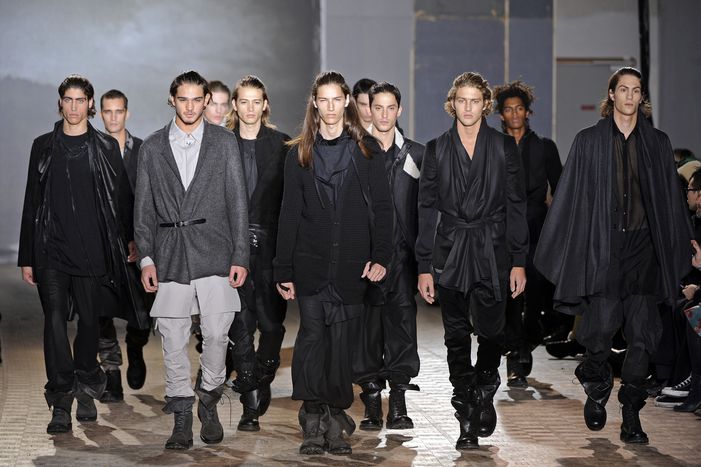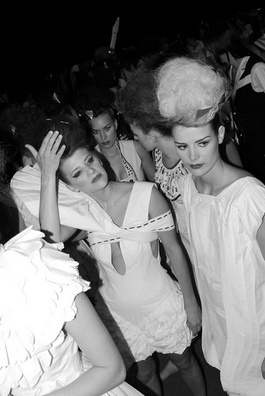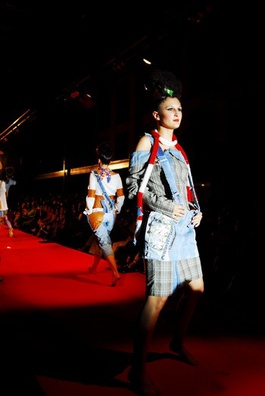
Quality, not quantity during fashion week in Europe
Published on
Translation by:
 Rosh Mahtani
Rosh Mahtani
From the old classics of Paris, Milan and London to the new modes in Stockholm, Madrid or Berlin: the 2009 autumn-winter fashion shows are streaming through Europe, despite the economic crisis and the criticism erupting around it
 An abundance of taffeta, sublime girls and snapping of flashes. Fashion Week is an opportunity for designers to present their collections to the public. The most well known shows are those of Paris, Milan and London. However, for a few years, ‘fashion week’ has been spreading to various European capitals. Each year, an armada of models, make-up artists and hairdressers are mobilised for the event.
An abundance of taffeta, sublime girls and snapping of flashes. Fashion Week is an opportunity for designers to present their collections to the public. The most well known shows are those of Paris, Milan and London. However, for a few years, ‘fashion week’ has been spreading to various European capitals. Each year, an armada of models, make-up artists and hairdressers are mobilised for the event.
From ‘press weeks’ to the ‘fashion weeks'
Organising this type of event brings prestige to a city. It is a country’s entire creations that are set before the stage. The ultimate goal, beyond the magic of the spectacle, lies in promoting and selling their creations. The shows have existed for a long time, but their concentration over the duration of about one week in one particular place is much more recent.
The first show saw the light of day in 1943, in New York, with the aim of rivaling the Parisian couture houses. Europe was in the midst of war, incapable of competing. The shows were reserved for journalists and were called ‘press week’ or ‘week of press’. At the end of the war, the large European capitals quickly returned to the front lines with the big names such as Chanel or Christian Dior. 'Initially, Milan was showing the ‘industrialists’, Paris the ‘houses and designers’ and London the ‘young talents'', explains Simon Laforce from Esmod fashion school in Paris.
Large versus small
Since 2000, these events have multiplied in Europe. Paris, London and Milan no longer monopolise fashion on the continent. Practically all the capital cities now have their appointed week. Faced with such a proliferation, some remain perplexed. 'These cities only have a ‘fashion week’ in so much as a name, this is no mistake when, in general, only four cities are cited when speaking of Fashion Week,’ notes a professional at the heart of fashion in Paris who wishes to remain anonymous.
Italian fashion has just been trouble by a similar polemic: Giorgio Armani, Italy’s star designer, declared in reference to Fashion Week in Rome: 'They have killed haute couture by parading people that were not worthy of it.’ For him, only Milan and Paris offer good quality shows. Armani has been criticised for his elitism and his reluctance to promote young Italian talent.
'Why not appreciate that these events revitalise an industry of textiles and of the ready-to-wear'
On the other hand, others prefer more local Fashion Weeks, like Jonny Johansson, ‘creative director’ of the label Acne Studios: 'We could have chosen to show our collection in Paris, but there are already so many people that show there that we prefer to enjoy better exposure here.' Marion Boucard, press manager at the house of Vivienne Westwood in Paris, does not understand these equivocations: 'Every designer benefits from presenting their creations in Fashion Weeks if they are invited to. Why not appreciate that these events revitalise an industry of textiles and of the ready-to-wear.'
An industry of dreams
 Fashion, an industry? The French federation of couture that organises Fashion Week in Paris refuses to convey the numbers. 'We do not have economic objectives to achieve. It is the quality that counts, not
Fashion, an industry? The French federation of couture that organises Fashion Week in Paris refuses to convey the numbers. 'We do not have economic objectives to achieve. It is the quality that counts, not
the quantity.' Yet, money does play a part in choice. In London, Fashion Week directly injects 25 million euros into the economy in attracting almost 5, 000 buyers and journalists from around the world, according to the British Fashion Council.
Because they attract so many potential prestigious clients, fashion weeks are sponsored by big labels,
such as Mercedez Benz in Berlin. In Paris, Renault took advantage of the situation to parade their cars. Here, like elsewhere, the crisis is threatening. In Berlin, the ‘news generation award’ which offered to fund a young designer’s entire collection was withdrawn due to sponsorship. In Milan, the event is cut down to one week, with a 10% decrease in shows. World renowned labels like La Perla or Trussardi are renouncing their shows due to budgetary restrictions.
In Milan, the event is cut down to one week, with a 10% decrease in shows
But the crises especially threatens the most modest and novel fashion weeks as well as less recognised designers. 'There will certainly be a ‘natural selection’ that will take place between the fashions weeks from the end of the year,' explains Simon Laforce.
Translated from La mode à la petite semaine en Europe


